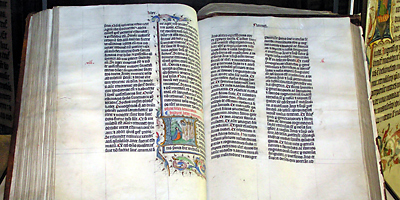
 The new English translation of the Roman Missal is set to be unveiled on the first Sunday of Advent. Still, some priests and lay people are having a hard time accepting the changes.
The new English translation of the Roman Missal is set to be unveiled on the first Sunday of Advent. Still, some priests and lay people are having a hard time accepting the changes.
Efforts are underway around the Diocese of Charleston to help people prepare. Many parishes are publishing excerpts in weekly bulletins, while others have held or are planning retreats and classes.
Bishop Robert E. Guglielmone has heard mixed reactions from priests in the diocese.
“People seem willing to accept that no translation is going to be perfect,” the bishop said. “My experience is the priests are open to the possibilities, but some are a little concerned after all these years of celebrating Mass with certain words and sentence structures. I encourage them to continue reading through the new text, because in some cases the language is more formal than we’ve been using in the past. I have so many parts of the Mass memorized, I’m going to have to start reading the new text for certain.”
Bishop Guglielmone urges all Catholics to be open to the new translation, to pray about it and learn some of the reasons why it was done, including to provide a translation to meet the needs of Catholics throughout the English-speaking world, not just the United States.
“Anything new is going to be a bit challenging, but some of the changes are really beautiful,” he said. “Is it perfect? No, but it’s very hard to find perfection.”
Father George Knab, of the Missionary Oblates of Mary Immaculate in Chicago, led parish retreats recently in Garden City, Camden and other locations as a way to help people become more receptive to the translation.
The retreat focused on improving participation at Mass. The priest discussed the history and reasons behind the updated translation, and encouraged participants to use the changes to grow in their faith.
“My focus is on full, active, conscious participation,” Father Knab said in an interview with The Miscellany. “I want to show people how the new translation is better, more accurate and more reverent, and when it’s well received, people will be able to participate more fully and actively in the liturgy.”
He highlighted some of the most obvious changes and the deeper meaning behind them. For instance, at the beginning of Mass, people will now respond to the priest’s “Peace be with you” by saying “And with your spirit.”
“That is really an invocation to the Holy Spirit, from the priest to the people and the people to the priest as they enter into the mystery of the Mass,” Father Knab said. “I try to point out how powerful the words are. They can shape our lives.”
He noted one change in a popular Eucharistic prayer, “from east to west” will now be “from the rising of the sun to its setting.”
“That is a Biblical reference to the prophet Malachi (Mal 1:11),” he said. “When we bring out Biblical references in the Mass, that can have a powerful impact on the people.”
Both Bishop Guglielmone and Father Knab said the new translation is most challenging for priests because the texts they read during Mass have gone through the most profound changes.
Father Knab said he has encouraged his fellow priests to study the new translation and pray over it so they will be fully prepared to celebrate Mass using the new words and phrases. Some of his suggestions can also be useful for lay people who seek more knowledge about the new translation and its foundations.
“Read the translation of the Missal on the internet, start meditating and pondering on what it means,” Father Knab said. “Learn about the word consubstantial, think about what incarnate means. These words are windows into mystery. If you ponder them, you can enter into the mystery of the Mass.”
He recommends that lay people print out copies of the new texts and read them over carefully.
Father Knab also tells Catholics the new version is not a repudiation of the Mass they’ve come to know over the past 40 years.
“I stick up for the old translation, because that was a good translation and we got used to it and it meant a lot to us,” he said. “The liturgy is being continually renewed from good to better, and this is another step in that direction.”
